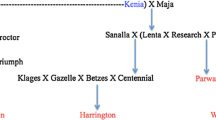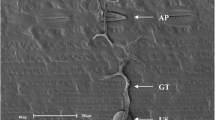Summary
The cultivar effect on infection frequency (IF) was studied in the seedling and adult plant stages of 15 spring barley cultivars. In both stages the cultivar effects were highly significant. The cultivars L94 and Vada represented the extremes. Vada having about 2 1/2 times fewer uredosori than L94. Between cultivars and development stage clear interactions occurred. Pauline f.i. had the same low IF as Vada in the seedling stage, but in the adult plant stage its IF was about 70% higher. Also other effects could influence the cultivar effects. Increasing leaf age appears to increase IF. The cultivar effect also seemed to depend on the level of IF. At high levels the cultivars differed far less than at low levels of IF. The cultivar effect on IF appeared correlated with partial resistance in the field (r=0.7) through a high correlation with the cultivar effect on latent period (r=0.8).
Similar content being viewed by others
References
Clifford, B. C., 1972. The histology of race-non-specific resistance to Puccinia hordei Otth. in barley. Proc. Eur. Medit. Cereal Rusts Conf., Prague, I: 75–78.
Eyal, Z., B. C. Clifford & R. M. Caldwell, 1968. A settling tower for quantitative inoculation of leaf blades of mature small grain plants with urediospores. Phytopathology 58: 530–531.
Parlevliet, J. E., 1975. Partial resistance of barley to leaf rust, Puccinia hordei. I. Effect of cultivar and development stage on latent period. Euphytica 24: 21–27.
Parlevliet, J. E., 1976a. Evaluation of the concept of horizontal resistance in the barley/Puccinia hordei host-pathogen relationship. Phytopathology 66: 494–497.
Parlevliet, J. E., 1976b. Screening for partial resistance in barley to Puccinia hordei Otth. Fourth Eur. Medit. Cereal Rust Conf. Interlaken, Switserland: 153–155.
Parlevliet, J. E. & A. van Ommeren, 1975. Partial resistance of barley to leaf rust, Puccinia hordei. II. Relationship between field trials, microplot tests and latent period. Euphytica 24: 293–303.
Plank, J. E. van der, 1963. Plant diseases: Epidemics and control. Academic Press, New York/London. 349 pp.
Russell, G. E., 1975. Deposition of e rysiphe graminis f.sp. hordei conidia on barley varieties of differing growth habit. Phytopath. Z. 84: 316–321.
Schaper, S., 1951. Die Bedeutung der Incubationszeit für die Züchtung Krautfäuleresistenter Kartoffelsorten. Z. Pfl. Zücht. 30: 292–299.
Zaag, D. E. van der, 1959. Some observations on breeding for resistance to Phytophthora infestans. Eur. Potato J. 2: 268–286.
Author information
Authors and Affiliations
Rights and permissions
About this article
Cite this article
Parlevliet, J.E., Kuiper, H.J. Partial resistance of barley to leaf rust, Puccinia hordei. IV. Effect of cultivar and development stage on infection frequency. Euphytica 26, 249–255 (1977). https://doi.org/10.1007/BF00026985
Received:
Issue Date:
DOI: https://doi.org/10.1007/BF00026985




